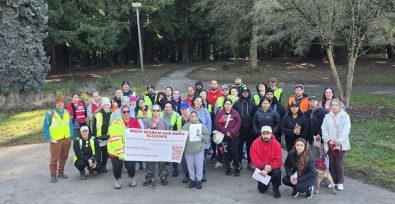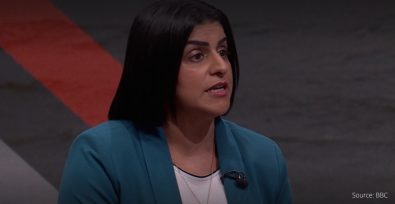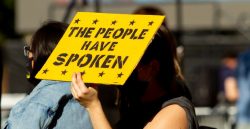Missing and Murdered Indigenous People (MMIP) and human trafficking are interwoven crises fueled by the same structural violence — and they must be addressed together through Indigenous-led, systemic solutions. So, to acknowledge this International Day of the World’s Indigenous Peoples on August 9, we are unpacking this harrowing and ongoing interconnected crisis: the disproportionate number of MMIP, especially women, girls, and Two-Spirit individuals, who are victims of human trafficking. MMIP are often not isolated tragedies, but similiar to the the causes of trafficking, are a result of a systemic pattern rooted in colonial violence, racism, and policy failures.
For this piece, I, Ellie Finkelstein, Campaigner and News Editor at Freedom United, spoke with Brandie Dieterle Raddadi, a member of the Board of Directors at Freedom United. Brandie is a human trafficking expert and an Indigenous survivor of sex trafficking. She is deeply involved with MMIP advocacy and search efforts in the state of Oregon, and her lived experience and frontline work are essential to understanding the reality of this crisis.
The research is consistent, yet the issue is persistent
Research consistently finds Indigenous women and girls most at risk for trafficking, with high overlap among MMIP cases. To make matters worse, these communities are often overlooked by global anti-trafficking efforts, an issue you can learn more about in Freedom United’s report, “Indigenous peoples and the and the anti-trafficking sector’s blind spot.”
According to a new report by Reuters, despite being only 5% of the population, Indigenous women and girls account for over 50% of trafficking victims in Canada.[1] In urban centers like Winnipeg and Vancouver, 60–80% of sexually exploited youth are Indigenous.[2]
In the U.S., reports show Indigenous people are disproportionately affected; for example, in Minnesota, nearly half of Indigenous women in sex work met the legal definition of sex trafficking.[3] In fracking regions with “man camps,” rates of sexual assault, trafficking, and violent victimization of Native women have doubled or tripled.[4]
However, exact trafficking rates are hard to quantify due an array of systematic failures, as Brandie and I discuss below. Nevertheless, research consistently finds Indigenous women and girls most at risk for trafficking, with high overlap among MMIP cases.
Systemic racism in law enforcement
Indigenous families consistently encounter indifference and bias when reporting missing loved ones. Law enforcement agencies often label disappearances as “runaways” or attribute them to addiction, homelessness, or mental illness — reinforcing their marginalization and implying their lives are less worthy of urgent attention. In too many cases, this becomes a self-fulfilling cycle: the assumption that Indigenous people are predisposed to “high-risk lifestyles” leads to slower, poorer-quality investigations, or none at all.[5]
This prejudice is not anecdotal — it is systemic. Law enforcement structures were not designed with Indigenous lives in mind and often reflect a broader social devaluation of Indigenous people.[6] Officers frequently lack cultural competency and understanding of Indigenous community dynamics.[7] Even when Indigenous families organize community-led searches, they face resistance: police often fail to support these efforts or share timely information.
As Brandie shared with me,
Indigenous families are leading search and rescue efforts for MMIP because law enforcement are often unwilling to partner with community members or dedicate sufficient time and resources to MMIP investigations.
In the case of Wilma Acosta who went missing in 2023, the Native American Emergency Response Oregon (www.naero.org) formed to assist Wilma’s elderly parents who were alone searching for her. When NAERO utilized tribal and volunteer resources, a body-shaped mass was discovered on the riverbed floor near where Wilma was last seen. Law enforcement was unwilling to send their own boat to check and were not supportive of our efforts. Wilma’s family was told to wait until the body decomposed so that it would float to the surface down river. Wilma’s remains would not be located on a river bank for several more weeks, prolonging the use of limited resources searching for her and exacerbating her family’s suffering. Finding Wilma was never a priority for law enforcement, but her disappearance made a big impact on the Native community.
Colonial legacies and intergenerational trauma
Colonial policies — from the Indian Act and residential schools in Canada[8] to the Indian Removal Act and boarding schools in the U.S.[9] — have dismantled Indigenous kinship systems, displaced communities, and inflicted generations of trauma.[10] Many Indigenous trafficking victims have histories of involvement in the foster care and juvenile criminal justice system, where they become separated from cultural anchors and may become more susceptible to grooming and exploitation.
In both Canada and the U.S., Indigenous children are overrepresented in child welfare systems and Indigenous women in the criminal justice system. These realities are not the product of personal failings but the outcome of policy design. The loss of land, language, culture, and family structures has created cycles of disconnection — conditions traffickers deliberately exploit.[11]
Jurisdictional chaos
In many cases, law enforcement fails to act not only because of bias, but because of bureaucratic confusion. Crimes committed on Indigenous land often fall into complex jurisdictional webs involving Indigenous, federal, state, or provincial authorities — with each agency unsure who holds responsibility.[12] Historically, Indigenous governments have had limited authority to prosecute non-Indigenous perpetrators, even when crimes occur on their land.
This legal limbo creates loopholes traffickers exploit. A perpetrator can commit a crime on tribal land and simply cross jurisdictional boundaries to avoid prosecution. Meanwhile, tribal authorities are frequently underfunded and unsupported, lacking the resources or legal power to act independently.[13]
The result? Perpetrators go unpunished, and Indigenous communities are left to fill the gaps with grassroots search and rescue groups — often with no formal support, funding, or information-sharing from police.
The way forward: Indigenous-led, culturally safe solutions
To truly address this crisis, we must insist that law enforcement and state institutions partner with Indigenous-led responses and honour community expertise. As Brandie told me:
MMIP cases exist in every Indigenous community, with some family units having multiple missing and murdered family members.
Indigenous folks know that help from authorities may never come. If the authorities are serious about protecting and serving Indigenous communities, formalized partnerships for MMIP responses with our communities is the only way forward.
We must move beyond symbolic gestures and invest in Indigenous-led emergency response teams, culturally safe support services, and trauma-informed interventions that center community leadership. That includes long-term funding, integrated interjurisdictional coordination, and the political will to dismantle racist systems that continue to harm Indigenous people.
On this International Day of the World’s Indigenous Peoples, let’s reject performative recognition and commit to structural change. The crisis of Missing and Murdered Indigenous People — and its inextricable link to human trafficking — is a national emergency born from colonialism, perpetuated by institutional neglect, and worsened by systemic racism.
It demands more than awareness — it demands action rooted in Indigenous leadership, justice, and dignity.
About MMIW Hope & Alliance
MMIW Hope & Alliance in Oregon monitors missing persons reports and organizes searches for missing Indigenous community members in both urban and rural areas. The Hope Alliance utilizes volunteers and donations — without funding and without participation from law enforcement. Quick action by the Hope Alliance has successfully located missing community members who were at high risk of exploitation and victimization. https://www.facebook.com/groups/1666249690878841/
Learn more about Brandie’s own trafficking experience as an Indigenous person through this illustrated story told through poetry and art: https://youtu.be/oOav4UihWOQ?si=d5ZK7KuQCGjZsDt9
Footnotes
[3] https://www.congress.gov/crs-product/R47010
[4] https://pdxscholar.library.pdx.edu/cgi/viewcontent.cgi?article=2521&context=honorstheses
[6] https://journals.sagepub.com/doi/10.1177/08912432231171171
[7] https://policycommons.net/artifacts/18953280/34-niac-final-report_version-11123_final_0/19853835/
[9] https://open.mitchellhamline.edu/cgi/viewcontent.cgi?article=1317&context=mhlr
[10] https://pubmed.ncbi.nlm.nih.gov/34734212/







-
Follow us on Facebook
5.6M
-
Follow us on Twitter
32K
-
Follow us on Instagram
8K
-
Subscribe to our Youtube
5.7K
Donate